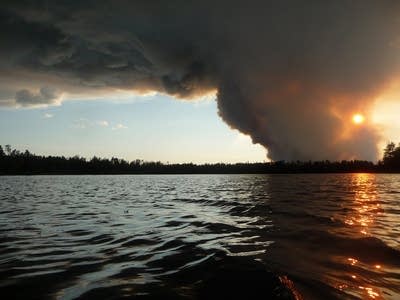Forest Service backs managers of Minn. Pagami Creek wildfire
Go Deeper.
Create an account or log in to save stories.
Like this?
Thanks for liking this story! We have added it to a list of your favorite stories.

The U.S. Forest Service today released three reports that found that the agency acted appropriately in fighting the Pagami Creek Wildfire last summer.
The fire began in mid-August as a small blaze that the forest service sought to manage rather than suppress. But on Sept. 12, the fire exploded across almost 90,000 acres. It was contained in late November.
The reports blame the day of rapid fire movement on a rare atmospheric condition that caused an unexpected plume-dominated fire. Deputy Forest Supervisor Tim Dabney said the condition creates its own weather system that further feeds the fire.
"You know whenever you've got your fireplace and you open the flue...it starts having this draft, then these flames start growing higher," Dabney said. "You basically end up having this tall column, having this sucking effect from around the fire that's bringing the oxygen in, and that's causing the fire to spread much more quickly."
Turn Up Your Support
MPR News helps you turn down the noise and build shared understanding. Turn up your support for this public resource and keep trusted journalism accessible to all.
Some local residents questioned why the forest service didn't try to put out the fire when it was still small.
The U.S. Forest Service regional decision review found that the Pagami fire was initially a good candidate for fire management based on weather conditions and the actions of previous fires in the area.
"There was no specific information, previous fire behavior on this incident, weather forecast or fire weather warnings that were missed or overlooked by the team or forest leadership that would have predicted the unprecedented movement of the fire on September 12, 2011," according to the report.
The decisions at the time were made by consulting with weather reports and fire modeling systems. Dabney said it was the right decision given the information they had at the time.
"If any of the decision makers had known that the fire was going to do what it did, would we have made that same decision? It's highly unlikely I would have," Dabney said. "I can't go back and use information that occurs in the future to make a decision in the past."
The fire modeling systems used by the forest service will be updated to include the experience of Pagami Creek Wildfire, Dabney said.
"Even whenever we have decisions that are consistent with regulation and policy, we can continue to learn and improve our processes, particularly in extreme and unusual events," Dabney said.
Six wilderness rangers were trapped in burning areas after the fire unexpectedly advanced on Sept. 12. They were not injured, although a report released two weeks ago detailed their experiences.
Dear reader,
Political debates with family or friends can get heated. But what if there was a way to handle them better?
You can learn how to have civil political conversations with our new e-book!
Download our free e-book, Talking Sense: Have Hard Political Conversations, Better, and learn how to talk without the tension.




